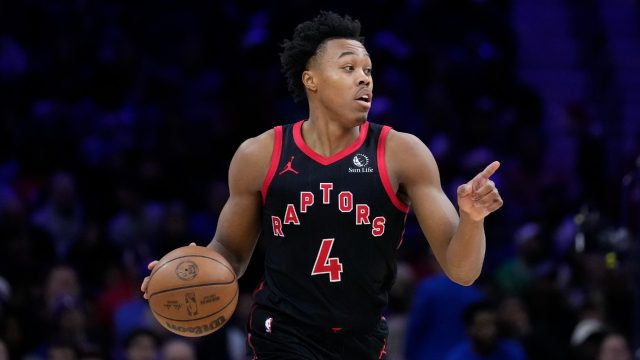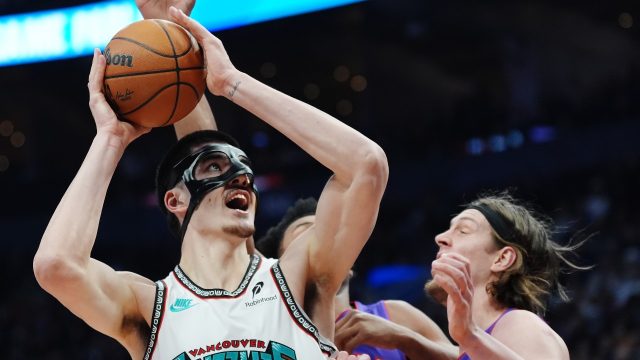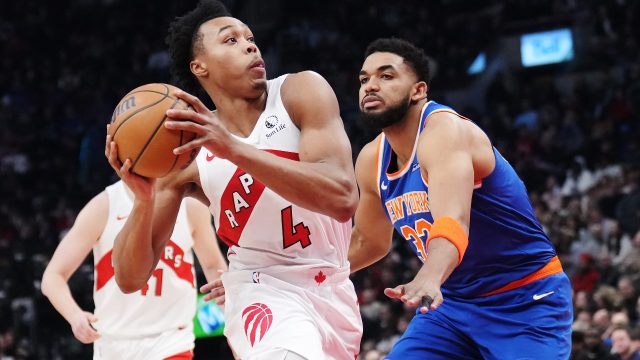
The Toronto Raptors were in position to do something significant at the NBA trade deadline, wanted to do something significant at the trade deadline and just before midnight on Wednesday night, they did just that.
The Raptors and New Orleans Pelicans had been bouncing around various constructions for a trade involving Brandon Ingram for a couple of weeks now, with sources telling me that Toronto was looking for a “significant piece to pair with Scottie” – as in Raptors cornerstone Scottie Barnes.
But what would the deal look like? For several days, it seemed like it would have to centre around RJ Barrett, the Mississauga, Ont. native who has played the best basketball of his career since arriving in Toronto from the New York Knicks along with Immanuel Quickley in the deal that sent out OG Anunoby and officially kicked off the Raptors’ rebuild.
But on Wednesday night, an executive with a Western Conference team floated another theory to me:
What if it was two of the Raptors’ expiring contracts – Bruce Brown and Chris Boucher worked, financially – for Ingram, himself a pending free agent. The expectation was Toronto would send out some draft capital for access to the Pelican wing’s ‘Bird rights’, which would give the Raptors the opportunity to sign him even though they are projected to be over the salary cap this summer, which would otherwise preclude them from signing a big-ticket player.
That basic idea for a trade made sense on a number of levels, including that the cash-strapped Pelicans were looking to shave future financial obligations rather than take on something like the two years and $57 million left on Barrett’s contract.
In the end, the two teams split the difference, with the Raptors including Canadian veteran Kelly Olynyk – who has one year and $13.5 million left on his contract – in the deal and sending the Pelicans the Indiana Pacers’ 2026 top-four protected first-round pick Toronto got when it traded Pascal Siakam last January, as well as a 2031 second-round pick.
-

-
NBA on Sportsnet
Livestream 40-plus regular season Toronto Raptors games, marquee matchups from around the association, select NBA Playoffs games, the NBA Draft and summer league action on Sportsnet+.
Does it make sense for the Raptors? We’ll get into that in a second, but first the final path on the Siakam trade: the Raptors sent the two-time All-Star (who just made his third All-Star Game as a member of the Pacers) to Indiana for what ended up being rookie Ja’Kobe Walter, third-year wing Ochai Agbaji and Ingram, a 27-year-old former All-Star.
If you squint, you can see the logic.
The Raptors have been hoping that their rebuild would have a bounce-back quality to it. Their dream scenario was to be bad enough this year to get lucky enough in the draft to add one of the All-Star-level talents projected to be in the top five in June, and – since we’re dreaming – maybe even Cooper Flagg, the Duke star projected in some corners as a franchise-changing future star. That would solve a lot of problems.
So far, so good on that front. The 16-35 Raptors have the fifth-worst record in the NBA after Wednesday night’s loss to the Memphis Grizzlies.
But with that accomplished, the hope was that the Raptors could begin their climb back to competitiveness sooner rather than later. This is a roster, let’s not forget, with Barnes about to start the first year of his five-year, $225-million contract next season, one that could jump to $270 million if he makes all-NBA this year and with Quickley, who will be in the second year of a five-year, $175-million deal. Teams with those kinds of commitments can’t troll through the bottom of the draft for multiple years.
It’s why the Raptors have held 29-year-old centre Jakob Poeltl so closely as the trade deadline approached. It wasn’t like he was off limits, but he wasn’t going to be sent away for a couple of second-round picks and some matching salary. It would have to be a good first-round pick (they traded him for what turned out to be the No. 8 overall pick in 2024, remember) or multiple protected firsts. That’s because they see Poeltl as someone that can help them win sooner than later.
Where does Ingram fit with the Raptors’ plan? Given he’s been out since early December with a severe ankle sprain, it’s not like the Raptors are hoping he can help them make a push for a run to the play-in tournament this season. Chances are it will be a slow ramp-up with careful attention paid to Ingram’s conditioning and the Raptors’ loss column.
The big-picture plan is that Ingram can help them be competitive next season and beyond. It’s plausible with a lineup that right now would feature Ingram, Barrett, Quickley, Barnes and Poeltl starting, Gradey Dick, Agbaji, Jamal Shead, Jonathan Mogbo and Walter off the bench, along with – let’s say – a top-five pick. It’s not a bad group to start with.
There are some financial complications to consider. Sportsnet’s Blake Murphy will cover them in detail in his post-trade-deadline, salary-cap breakdown but suffice to say the Raptors are looking at roughly $180 million in salary for 11 roster spots. That’s a big investment for a team coming off, give or take, a 25-win season.
But the biggest complication, for better or worse, is Ingram.
The reason Ingram is available is because he’s a polarizing player. Few question his talent. He was the No. 2 overall pick in the 2016 draft and in his six seasons with New Orleans he’s averaged 23 points, 5.5 rebounds and 5.2 assists while converting 37.2 per cent of nearly five three-pointers a game. The only other players to average 23/5/5 and shoot 37 per cent on threes over the same stretch are Kevin Durant and Steph Curry. Ingram was an All-Star when he was 22 years old.
But critics point to his durability, or lack thereof – after playing 79 games as a rookie, he averaged just 56 games a season the seven full seasons since and has played just 18 this year – as an issue, justifiably. But perhaps even more concerning is a reputation for being a little lacking in get-up-and-go. “Good guy, not the most self-motivated,” said one longtime Eastern Conference scout. “Change of scenery might do him good.”
Another scout I spoke with from a Western Conference team was more blunt: “No real grit, his defence is suspect … not many Raptors’ characteristics.”
And that’s without getting into the pure basketball side of it where Ingram, like Barnes, does his best work on offence in the mid-range. It’s not that Ingram can’t function well behind the three-point line and give Barnes the kind of spacing he needs – he’s shot 39 per cent or more in three different seasons – it’s more that he prefers not to operate that way.
Counter to that: the Raptors have Garrett Temple, who played two seasons alongside Ingram with the Pelicans. Chances are they have some insights no outside observer could match that gave them some confidence that Ingram is a player worth investing in.
As always in these kinds of deals, the Raptors are making a bet, and their bet is on Ingram’s talent. Six-foot-eight wings who can score and pass are rare and getting them at less than the full max rate – and we’ll see about that – is rarer still.
Can the Raptors sign Ingram for a reasonable (by the standards of NBA weirdo economics) deal in the range of three years and $120 million? It’s less than ‘max money’ and it’s not like there’s a lineup of teams with salary-cap space they would have to compete with.
Can Ingram stay healthy?
If both of those variables play out in the Raptors’ favour, this could be the kind of deal that will allow team president Masai Ujiri and the rest of his front office to make the leap from bottom feeder to relevant in the space of 18 months. It can light the path to a promising future. For Ujiri, who is heading into a contract year next season, it’s a nice place to negotiate from, if he’s inclined.
If the cards don’t come up in the Raptors’ favour, if Ingram ends up forcing their hand and getting a richer deal than expected and then trundles along playing 55 or 60 games a year and doing not much in them, it will be poor use of a first-round pick, a lot of money wasted and a rebuild that might have to be revisited.






